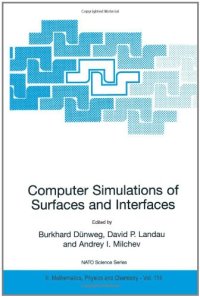
Ebook: Computer simulations of surfaces and interfaces
- Tags: Statistical Physics Dynamical Systems and Complexity, Surfaces and Interfaces Thin Films, Physical Chemistry, Theoretical Mathematical and Computational Physics, Characterization and Evaluation of Materials
- Series: NATO Science Series 114 Series II
- Year: 2003
- Publisher: Springer Netherlands
- Edition: 1
- Language: English
- djvu
Studies of surfaces and interactions between dissimilar materials or phases are vital for modern technological applications. Computer simulation methods are indispensable in such studies and this book contains a substantial body of knowledge about simulation methods as well as the theoretical background for performing computer experiments and analyzing the data.
The book is self-contained, covering a range of topics from classical statistical mechanics to a variety of simulation techniques, including molecular dynamics, Langevin dynamics and Monte Carlo methods. A number of physical systems are considered, including fluids, magnets, polymers, granular media, and driven diffusive systems. The computer simulation methods considered include both standard and accelerated versions. The simulation methods are clearly related to the fundamental principles of thermodynamics and statistical mechanics.
Studies of surfaces and interactions between dissimilar materials or phases are vital for modern technological applications. Computer simulation methods are indispensable in such studies and this book contains a substantial body of knowledge about simulation methods as well as the theoretical background for performing computer experiments and analyzing the data.
The book is self-contained, covering a range of topics from classical statistical mechanics to a variety of simulation techniques, including molecular dynamics, Langevin dynamics and Monte Carlo methods. A number of physical systems are considered, including fluids, magnets, polymers, granular media, and driven diffusive systems. The computer simulation methods considered include both standard and accelerated versions. The simulation methods are clearly related to the fundamental principles of thermodynamics and statistical mechanics.